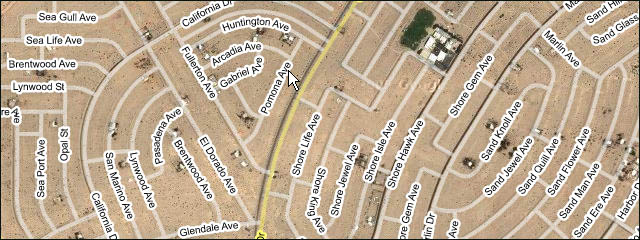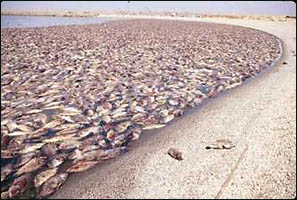

Plagues & Pleasures on the Salton Sea
Subject Normally the lake would have just evaporated like previous bodies of water in the area, but the portion of the Imperial Valley that remained above water was still a big farming area and so the sea was fed by agricultural runoff as well as the rivers created by the 1905-7 flood. However, this means that the pure water that evaporates is replaced by salty, polluted water — the New River which flows from maquiladora-choked Mexicali into the Salton Sea is the most polluted waterway in North America, full of heavy metals, pesticide and biological toxins — and so the Salton Sea is now saltier than the ocean and an ecological nightmare. This documentary covers the history of the lake since its formation a hundred years ago (complete with clips from oh-so-1950s tourism films) and introduces the viewer to several of the few local residents. I saw it at the Pacific Film Archive in Berkeley; it's also playing at various film festivals all over the place.
Evaluation
A lot of Californians, let alone others, haven't even heard of the Salton Sea. I had; in fourth grade we had to make relief maps of California out of flour paste and paint them for elevation, and it was hard to miss the huge lake down at the south end. But I didn't actually go there until 16 August 1998, on the way back from a trip to Joshua Tree with Neil Guy. There were some picnic benches along the lakefront that had clearly not been used in years, possibly because the shoreline was covered in dead fish. Plagues & Pleasures on the Salton Sea explains the deal with the fish. In the 1930s fish were introduced to the Salton Sea in hopes of making it a tourist destination for fishing enthusiasts. It worked: the fish thrived, or at least the tilapia did — there are 100 million tilapia in the Salton Sea. But salty water carries less oxygen than fresh water, so as the lake grew saltier, oxygen stores were depleted... and hot water carries less oxygen than cold water, so in late summer, the fish suffocate at a rate of about ten million a week, leaving blankets of dead tilapia miles long and miles wide along the shore. This annual die-off attracts flies. Flies lay eggs, which hatch into maggots, which get into the water. Some of these maggots carry botulism. The surviving fish eat the infected maggots and contract botulism. These fish are then eaten by birds. The birds die. There are guys at the Park Service whose entire job description in the summer is to round up the sick and dead pelicans. (Because California's coastal wetlands are gone, the Salton Sea area has become a crucial haven for migrating birds.) Finally, the dead fish that end up back in the lake serve as nutrients for algae, leading to enormous, malodorous algae blooms, which feed the surviving fish and allow them to partially replenish their stocks for next summer's die-off. As for the picnic benches — in the 1950s and even into the '60s, the Salton Sea was a popular vacation destination with a yacht club, an annual boat race, Hawaiian luaus, even songs by Beach Boys knock-offs. Sinatra played there. Eisenhower visited. So in 1958, a group of developers built Salton City, a resort town with 250 miles of paved streets
The few communities that did spring up along the lakeshore were severely flooded in the 1970s, as the level of the lake rose and destroyed a lot of the infrastructure. Tourism had already dwindled, and the flood pretty much spelled the end of the Salton Sea as a potential resort area. Now the fear is that with a new deal to redirect to San Diego much of the water that currently flows into the lake, the Salton Sea will evaporate into a small puddle and the contaminated soil thereby exposed will blow northward into the ritzy Palm Springs region. Unlikely? This is pretty much exactly what happened to the Aral Sea in the former Soviet Union! Its feeders were diverted, it dried up (losing 80% of its volume and actually splitting into two lakes), and now toxic dust storms in the Aral region have caused a spike in cancer rates and lung disease. Infant mortality has multiplied thirtyfold. Soon the lake won't even have enough water left for Islam Karimov to boil political prisoners in. So will anyone do anything about the Salton? Sonny Bono made some noise about it and even got Newt Gingrich to come down and make a speech, but then he skied into a tree and the Salton Sea faded as a fashionable cause. At the screening of the film some volunteers were handing out postcards to send to Arnold Schwarzenegger asking him to save the Salton Sea in memory of Sonny Bono. When your movement depends on the empathy of one has-been celebrity for another, you've got problems.
Return to the Calendar page! | ||||||


